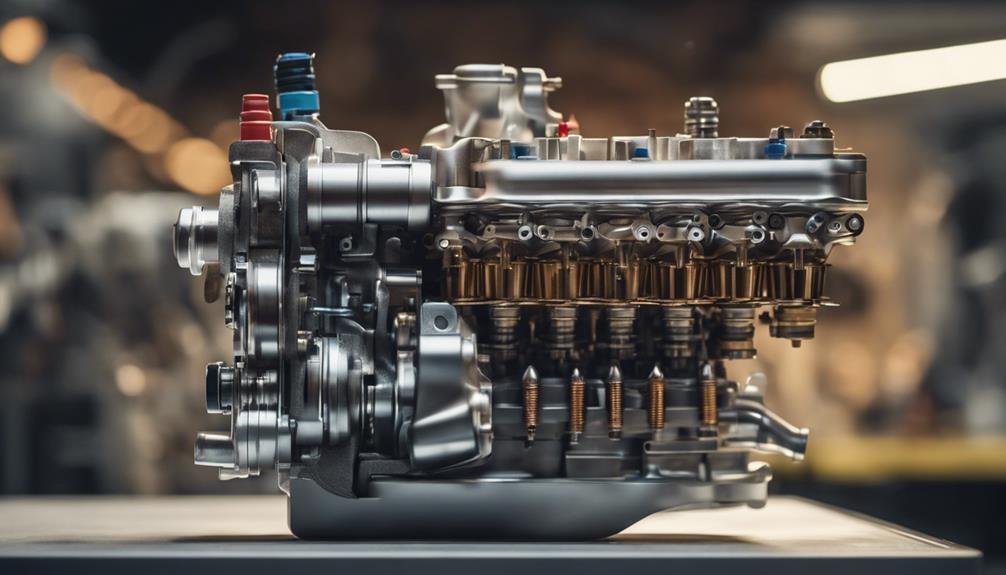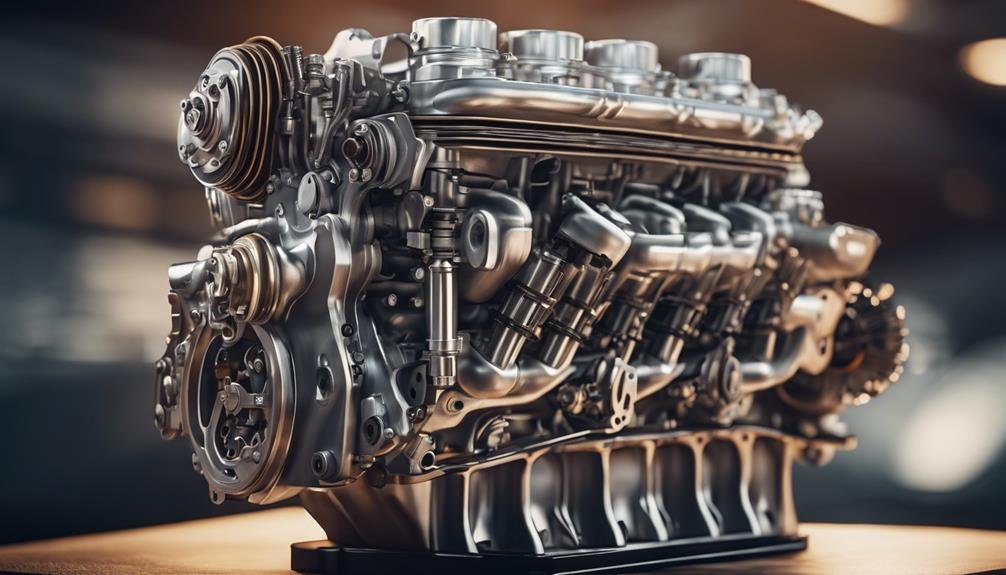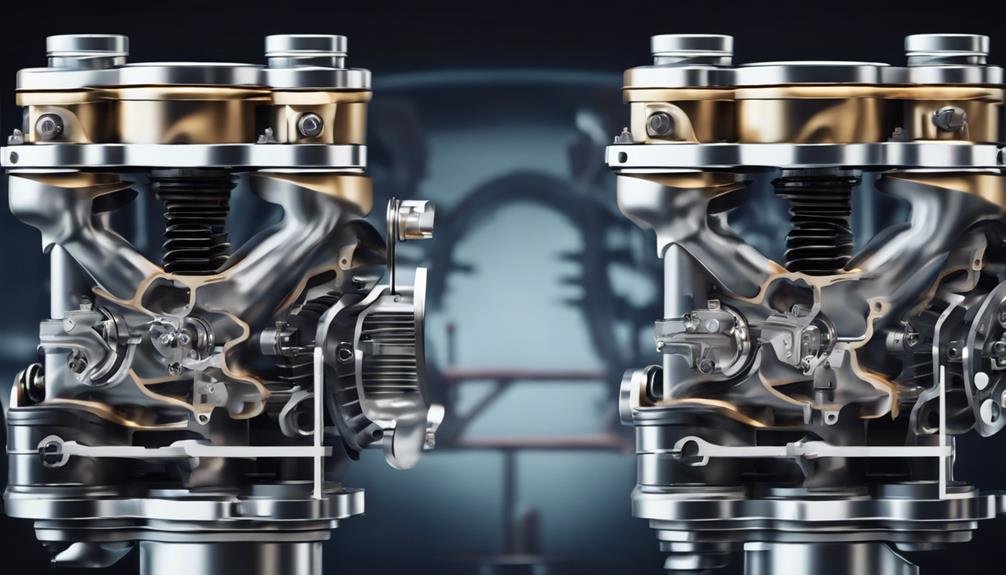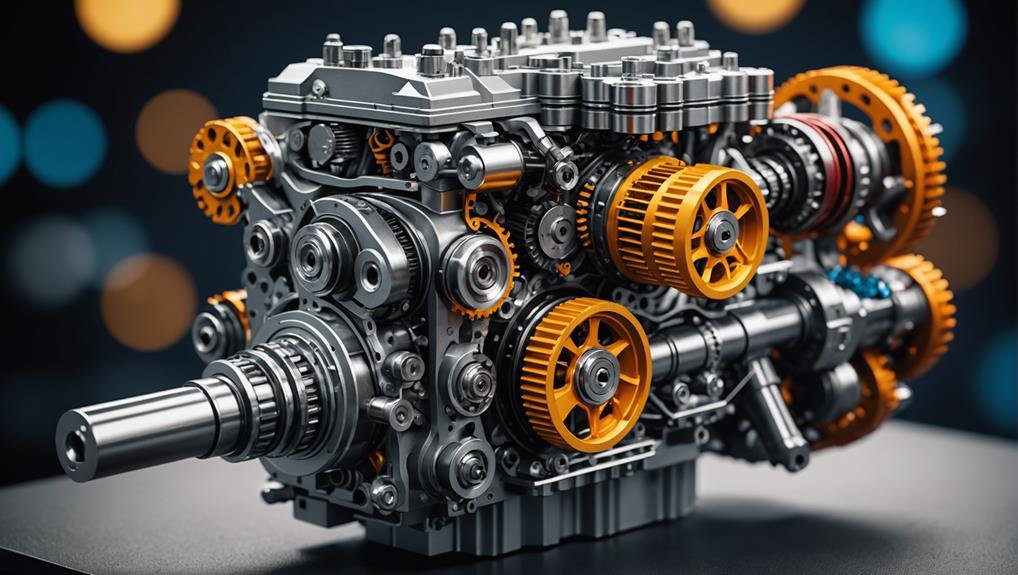You're likely familiar with the basics of a four-stroke engine, but let's break down the key components that make it run. A four-stroke engine relies on five important parts: the piston and crankshaft assembly, intake and exhaust valve system, spark plug and fuel ignition, camshaft, and engine block. These components work together to facilitate the four-stroke cycle of intake, compression, power, and exhaust. Understanding how these parts interact is vital for optimizing engine performance. As you investigate these components in more detail, you'll uncover the intricacies of four-stroke engines and gain a deeper appreciation for the machinery that powers your vehicles.
Key Takeaways
- The piston and crankshaft assembly converts gas pressure into rotational motion, generating power in a four-stroke engine.
- The intake and exhaust valve system controls airflow, allowing air-fuel mixture in and releasing burnt gases, impacting engine performance.
- The spark plug and fuel ignition system ignites the air-fuel mixture, with precise timing essential for engine performance and efficiency.
- The crankshaft and connecting rod assembly converts reciprocating motion to rotational motion, transferring force from the piston to the crankshaft.
- The camshaft controls valve timing, ensuring proper combustion and engine efficiency by regulating the opening and closing of intake and exhaust valves.
Key Engine Components Overview
As you investigate the inner workings of a four-stroke engine, you'll find that several key components work in harmony to convert chemical energy into mechanical energy.
The engine's operation relies on the seamless coordination of these components, each playing an essential role in the combustion cycle. At the heart of the engine is the piston, responsible for converting gas pressure into rotational motion.
The crankshaft, connected to the piston, converts reciprocating motion into rotational motion, ultimately powering the engine. The camshaft, valves, and spark plug work in tandem to facilitate the intake of fresh air-fuel mixture and the release of exhaust gases.
The valves regulate the flow of gases, while the spark plug ignites the fuel-air mixture, initiating the power stroke. These components work in harmony to complete the four-stroke cycle, ensuring the engine runs efficiently and effectively.
Understanding the roles of these components is essential to appreciating the intricacies of a four-stroke engine, and how they work together to generate power.
How Four-Stroke Engines Function
When you turn the key or press the ignition, the four-stroke engine springs to life, initiating a repetitive cycle of four distinct phases that convert chemical energy into mechanical energy.
This internal combustion engine's combustion cycle revolves around the intake stroke, compression stroke, power stroke, and exhaust stroke.
During the intake stroke, air and fuel are drawn into the cylinder, forming an air-fuel mixture. The compression stroke follows, where this mixture is compressed, preparing it for ignition.
Next, the power stroke ignites the fuel, causing a controlled explosion that drives the piston down, ultimately generating mechanical energy. Finally, the exhaust stroke expels the exhaust gases as the piston moves back up in the cylinder.
This continuous process is the backbone of four-stroke engines, allowing them to efficiently convert chemical energy into mechanical energy.
Spark Ignition and Compression

Operating a four-stroke engine requires a reliable ignition system, and spark ignition and compression are two fundamental methods used to ignite the air-fuel mixture. You're likely familiar with petrol engines, which use spark ignition to combust the air-fuel mixture, and diesel engines, which employ compression ignition.
But have you ever wondered how these methods differ?
Here are the key differences between spark ignition and compression:
- Spark Ignition: used in petrol engines, relies on spark plugs to initiate combustion, and requires a lower compression ratio.
- Compression Ignition: employed in diesel engines, where the fuel ignites due to the high compression ratio, and doesn't require spark plugs.
- Ignition System: the type of ignition system used determines whether an engine is a spark ignition engine (petrol) or compression ignition engine (diesel).
- Engine Performance: the choice of ignition method affects engine performance, with spark ignition typically used in smaller engines and compression ignition in larger ones.
Understanding the difference between spark ignition and compression is essential for efficient engine performance and efficiency. By grasping these fundamental concepts, you'll be better equipped to appreciate the intricacies of four-stroke engines.
Piston and Crankshaft Assembly
You'll find that the piston and crankshaft assembly is the heart of a four-stroke engine, where the piston's up-and-down motion is converted into rotary motion that ultimately powers your vehicle.
Inside the cylinder, the piston moves up and down, transferring the force of the expanding gas to the crankshaft via the connecting rod. This synchronized movement guarantees that the crankshaft converts the linear motion of the piston into rotational motion, which drives the transmission and ultimately the wheels.
The crankshaft is a vital component that converts the reciprocating motion of the piston into usable rotary motion for different applications. As the piston moves up and down, it creates a reciprocating motion, which the crankshaft converts into rotational motion, providing the mechanical power output for propulsion.
Essentially, the piston and crankshaft assembly is necessary for the operation of a four-stroke engine, providing the power needed to move your vehicle. Without this critical component, your engine wouldn't be able to generate the power needed to propel your vehicle forward.
Intake and Exhaust Valve System

In a four-stroke engine, the intake and exhaust valve system plays a critical role in controlling airflow and combustion, allowing your engine to breathe and thrive. This system is responsible for managing the air-fuel mixture that enters the cylinder and the exhaust gases that leave it.
Here are some key aspects of the intake and exhaust valve system:
- The intake valve allows the air-fuel mixture into the cylinder during the intake stroke, while the exhaust valve opens to release the burnt gases during the exhaust stroke.
- Proper timing and sealing of the valves are essential for engine performance and efficiency.
- Valve clearance adjustments are necessary to maintain efficient engine operation.
- The valve timing and clearance affect airflow and combustion, which in turn impact engine performance.
Proper valve timing and clearance ensure that your engine runs smoothly and efficiently.
As you can see, the intake and exhaust valve system is crucial to your engine's performance. By understanding how this system works, you can better appreciate the intricate mechanisms that keep your engine running.
Spark Plug and Fuel Ignition
As the air-fuel mixture enters the cylinder, the spark plug ignites it, generating the power stroke that ultimately drives your engine's performance. The spark plug's precise ignition timing guarantees efficient fuel ignition, which is essential for peak engine performance and fuel efficiency. Proper spark plug maintenance is vital, as a worn-out spark plug can greatly reduce engine performance and increase fuel consumption.
| Spark Plug Characteristics | Description |
|---|---|
| Heat Range | Determines the spark plug's ability to dissipate heat from the combustion chamber |
| Design | Varies based on factors like compression ratio and fuel type |
| Maintenance | Regular replacement ensures peak engine performance and fuel efficiency |
The spark plug's heat range determines its ability to dissipate heat from the combustion chamber, making it a critical component in maintaining peak engine performance. Different engines require specific spark plug designs based on factors like compression ratio and fuel type. By understanding the importance of spark plug maintenance and selecting the right spark plug for your engine, you can ensure peak engine performance, fuel efficiency, and overall driving experience.
Four-Stroke Cycle Process

The four-stroke cycle, a fundamental process that keeps your engine running, breaks down into four distinct strokes: intake, compression, power, and exhaust. These strokes work together to convert chemical energy from fuel into mechanical energy, ultimately powering your vehicle.
Here's a breakdown of each stroke:
- Intake stroke: The piston moves down, drawing in air and fuel mixture into the cylinder.
- Compression stroke: The air-fuel mixture is compressed by the rising piston, preparing it for combustion.
- Power stroke: Combustion occurs, driving the piston down with the force of the explosion.
- Exhaust stroke: The piston moves up, expelling the burnt gases out of the cylinder to complete the cycle.
As you can see, each stroke plays a vital role in the engine's operation. The intake stroke sets the stage, the compression stroke prepares the mixture, the power stroke generates energy, and the exhaust stroke clears the way for the next cycle. By understanding these strokes, you'll gain a deeper appreciation for the intricate process that keeps your engine running smoothly.
Engine Parts and Functions
You rely on several key components working together seamlessly to keep your four-stroke engine running smoothly. The piston, crankshaft, camshaft, spark plug, valves, carburetor, connecting rod, and cylinder all play vital roles in the engine's operation.
The piston transfers forces to the crankshaft, while the spark plug ignites the fuel-air mixture for power generation. Meanwhile, the camshaft controls the timing of valve openings, ensuring proper fuel-air mixture combustion. The valves regulate the intake and exhaust of gases, and the connecting rod transfers motion from the piston to the crankshaft. The cylinder houses the piston and fuel mixture, facilitating the four-stroke engine cycle.
As these components work together, they enable efficient power generation and mechanical motion. Understanding the functions of each part is crucial to appreciating the complexities of a four-stroke engine.
Common Applications and Uses

With a solid grasp of the components working together in harmony, you can now examine the different applications where four-stroke engines prove their worth. The unique characteristics of four-stroke engines, such as quieter operation, better fuel efficiency, and higher torque at lower RPMs, make them ideal for different applications.
Some common uses of four-stroke engines include:
- Watercraft, such as boats and personal watercraft
- Motorcycles, where their high torque and fuel efficiency are beneficial
- Automobiles, where their reliability and performance are crucial
- Riding lawnmowers and off-road vehicles, where their durability and low emissions are valuable
These applications take advantage of the four-stroke engine's design, which allows for cleaner emissions and eliminates the need for fuel premixing. The combustion process in four-stroke engines also provides a more efficient and environmentally friendly alternative to two-stroke engines.
Engine Design and Engineering
Optimizing power output in four-stroke engines requires careful consideration of factors like air intake, engine size, and RPM. As you explore the world of internal combustion (IC) engines, you'll realize that engine design and engineering play a vital role in maximizing performance.
When the piston moves from BDC (bottom dead center) to TDC (top dead center), the intake and exhaust valves open and close, allowing air and fuel to enter the combustion chamber. Engine components, such as the cylinder head and engine block, are meticulously designed to facilitate efficient combustion and minimize energy loss.
However, high engine speeds can lead to issues like piston ring flutter and valve float, affecting overall performance. To mitigate these issues, engine designs often incorporate porting techniques to reduce resistance in intake and exhaust paths, enhancing engine performance.
Frequently Asked Questions
What Are the Main Components of a 4-Stroke Engine?
You're wondering what makes a 4-stroke engine tick? Well, the main components you need to know are the piston, crankshaft, camshaft, spark plug, and cylinder, which work together to keep your engine running smoothly.
What Are the 5 Key Events of a 4-Stroke Engine?
You're wondering what makes a 4-stroke engine tick, and it's the 5 key events: intake, where you draw in air-fuel mixture, followed by compression, power, exhaust, and ignition, all working together seamlessly.
What Are the Components and Operation of a Four-Stroke Engine?
You're probably wondering how a four-stroke engine works and what makes it tick. In essence, it's a precision machine that relies on the harmonious operation of its components to convert chemical energy into mechanical energy.
What Is the Breakdown of a 4-Stroke Engine?
You're looking at the breakdown of a 4-stroke engine, which involves the process of intake, compression, power, and exhaust. It's a cycle that repeats in each cylinder, generating power and propelling your vehicle forward.
Conclusion
As you now understand the key components of a four-stroke engine, you've gained insight into the intricate mechanics driving your vehicle.
From the spark ignition and compression to the piston and crankshaft assembly, intake and exhaust valve system, and four-stroke cycle process, each part plays an essential role in converting chemical energy into mechanical energy.
With a deeper appreciation for engine design and engineering, you're better equipped to appreciate the complexity and sophistication of these remarkable machines.
